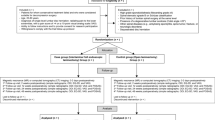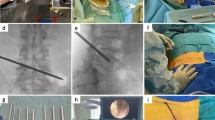Abstract
Purpose
To evaluate the relationship between nerve root retraction time, post-operative radiculitis and patient reported outcomes.
Methods
Patients who underwent single- or multi-level lumbar discectomy between 2020 and 2022 for lumbar disk herniations were prospectively followed with pre-operative, interoperative and post-operative variables including radiculitis and patient reported outcomes including VAS, ODI and CAT domains Pain interference, Pain intensity and Physical function. Intraoperative nerve root retraction time was recorded. Paired sample two-tailed t-test and multivariate regression were utilized with p < 0.05 being significant.
Results
A total of 157 patients who underwent single- or multi-level endoscopic lumbar discectomy. Average patient age was 44 years, and 64% were male patients. Nerve retraction time ranged from 4 to 15 min. Eighteen percent reported new radiculitis at 2-weeks post-operatively. In patients with new-onset radiculitis 79.2% reported significantly worse VAS leg at 2 weeks post-operative (4.2 vs. 8.3, p < 0.001) compared to 12.5% who had improved VAS leg (9.3 vs. 7, p = 0.1181). Patients with radiculitis and worse VAS scores had substantially longer nerve retraction time (13.8 ± 7.5 min) than patients with improved VAS leg (6.7 ± 1.2 min). At 6 months, patients with longer nerve retraction time had no significant improvement in the ODI or CAT compared to the baseline.
Conclusions
This is the first study in discectomy literature to show that new onset radiculitis and poorer outcomes in VAS leg correlate with longer nerve retraction time at early and later time points.



Similar content being viewed by others
References
Dydyk AM, Ngnitewe Massa R, Mesfin FB (2022) Disc Herniation. In: StatPearls [Internet]. Treasure Island (FL): StatPearls Publishing
Lee SG, Ahn Y (2021) Transforaminal endoscopic lumbar discectomy: basic concepts and technical keys to clinical success. Int J Spine Surg 15(suppl 3):S38–S46
Akinduro OO, Kerezoudis P, Alvi MA et al (2017) Open Versus minimally invasive surgery for extraforaminal lumbar disk herniation: a systematic review and meta-analysis. World Neurosurg 108:924-938.e3
Ahn Y, Lee SG, Son S, Keum HJ (2019) Transforaminal endoscopic lumbar discectomy versus open lumbar microdiscectomy: a comparative cohort study with a 5-year follow-up. Pain Phys 22(3):295–304
Barber SM, Nakhla J, Konakondla S, Fridley JS, Oyelese AA, Gokaslan ZL, Telfeian AE (2019) Outcomes of endoscopic discectomy compared with open microdiscectomy and tubular microdiscectomy for lumbar disc herniations: a meta-analysis. J Neurosurg Spine 31:1–14
Gadjradj PS, Harhangi BS, Amelink J, van Susante J, Kamper S, van Tulder M, Peul WC, Vleggeert-Lankamp C, Rubinstein SM (2021) Percutaneous transforaminal endoscopic discectomy versus open microdiscectomy for lumbar disc herniation: a systematic review and meta-analysis. Spine 46(8):538–549
Page PS, Ammanuel SG, Josiah DT (2022) Evaluation of endoscopic versus open lumbar discectomy: a multi-center retrospective review utilizing the American college of surgeons’ national surgical quality improvement program (ACS-NSQIP) database. Cureus 14(5):e25202
Gadjradj PS, Rubinstein SM, Peul WC et al (2022) Full endoscopic versus open discectomy for sciatica: randomised controlled non-inferiority trial. BMJ 21(376):e065846
Papuga MO, Mesfin A, Molinari R, Rubery PT (2016) Correlation of PROMIS physical function and pain CAT instruments with oswestry disability index and neck disability index in spine patients. Spine 41(14):1153–1159. https://doi.org/10.1097/BRS.0000000000001518
Uribe JS, Isaacs RE, Youssef JA, Khajavi K, Balzer JR, Kanter AS, Küelling FA, Peterson MD, SOLAS Degenerative Study Group (2015) Can triggered electromyography monitoring throughout retraction predict postoperative symptomatic neuropraxia after XLIF? Results from a prospective multicenter trial. European Spine Journal. vol 24, p 378–85
Frymoyer JW (1988) Back pain and sciatica. N Engl J Med 318:291–300
Jordan J, Konstantinou K, O’Dowd J (2009) Herniated lumbar disc. BMJ Clin Evid 2009:1118
Buser Z, Tekmyster G, Licari H, Lantz JM, Wang JC (2021) Team approach: management of an Acute L4–L5 Disc Herniation. JBJS Rev 9(10):e21
Peul WC, van Houwelingen HC, van den Hout WB, Brand R, Eekhof JA, Tans JT, Thomeer RT, Koes BW, Leiden-The Hague Spine Intervention Prognostic Study Group (2007) Surgery versus prolonged conservative treatment for sciatica. New England Journal of Medicine. vol 356(22), p 2245–2256
Weinstein JN, Tosteson TD, Lurie JD, Tosteson AN, Hanscom B, Skinner JS, Abdu WA, Hilibrand AS, Boden SD, Deyo RA (2006) Surgical versus nonoperative treatment for lumbar disk herniation: the spine patient outcomes research trial (SPORT): a randomized trial. JAMA 296(20):2441–2450
Kreiner DS, Hwang SW, Easa JE, Resnick DK, Baisden JL, Bess S, Cho CH, DePalma MJ, Dougherty P 2nd, Fernand R, Ghiselli G, Hanna AS, Lamer T, Lisi AJ, Mazanec DJ, Meagher RJ, Nucci RC, Patel RD, Sembrano JN, Sharma AK, Summers JT, Taleghani CK, Tontz WL Jr, Toton JF; North American Spine Society (2014) An evidence-based clinical guideline for the diagnosis and treatment of lumbar disc herniation with radiculopathy. Spine Journal. vol 14(1), p 180–191
Takahashi K, Shima I, Porter RW (1999) Nerve root pressure in lumbar disc herniation. Spine 24(19):2003–2006
Spencer DL, Miller JA, Bertolini JE (1984) The effect of intervertebral disc space narrowing on the contact force between the nerve root and a simulated disc protrusion. Spine 9:422–426
Matsui H, Kitagawa H, Kawaguchi Y et al (1995) Physiologic changes of nerve root during posterior lumbar discectomy. Spine 20:654–659
Dewing CB, Provencher MT, Riffenburgh RH, Kerr S, Manos RE (2008) The outcomes of lumbar microdiscectomy in a young, active population: correlation by herniation type and level. Spine 33(1):33–38
Ko S, Kwon J (2022) Does discectomy improve low back pain as well as radiating pain in patients with lumbar herniated intervertebral disc (HIVD)? Medicine (Baltimore) 101(1):e27559
Zanoli G, Strömqvist B, Jönsson B (2001) Visual analog scales for interpretation of back and leg pain intensity in patients operated for degenerative lumbar spine disorders. Spine 26(21):2375–2380
Mueller K, McGowan J, Kane S, Voyadzis JM (2019) Evaluation of retraction time as a predictor of postoperative motor dysfunction after minimally invasive transpsoas interbody fusion at L4–L5. J Clin Neurosci 61:124–129
Parke WW, Watanabe R (1985) The intrinsic vasculature of the lumbosacral nerve spinal nerve roots. Spine 10:508–515
Chen Z, Zhang L, Dong J, Xie P, Liu B, Chen R, Li S, Liu Z, Yang B, Feng F, He L, Yang Y, Pang M, Rong L (2022) Percutaneous transforaminal endoscopic discectomy versus microendoscopic discectomy for lumbar disc herniation: 5-year long-term results of a randomized controlled trial. Spine 48(2):79–88
Khechen B, Haws BE, Patel DV, Bawa MS, Elboghdady IM, Lamoutte EH, Karmarkar SS, Singh K (2019) PROMIS physical function score strongly correlates with legacy outcome measures in minimally invasive lumbar microdiscectomy. Spine 44(6):442–446
Wang S, Hebert JJ, Abraham E, Vandewint A, Bigney E, Richardson E, El-Mughayyar D, Attabib N, Wedderkopp N, Kingwell S, Soroceanu A, Weber MH, Hall H, Finkelstein J, Bailey CS, Thomas K, Nataraj A, Paquet J, Johnson MG, Fisher C, Rampersaud YR, Dea N, Small C, Manson N (2022) Postoperative recovery patterns following discectomy surgery in patients with lumbar radiculopathy. Sci Rep 12(1):11146
Author information
Authors and Affiliations
Corresponding author
Ethics declarations
Conflict of interest
No conflicts of interest for the current study. Disclosures outside of submitted work: MCG - Product Design/Royalties: Integrity Spine; Grants/ Research support: AO Spine (Paid directly to institution/employer); MiMedx (past, Paid directly to institution/employer), Nexus Spine (Paid directly to institution/employer), Medical Metrics (Paid directly to institution/employer); ZB – Grants/ Research support: AO Spine (Paid directly to institution/employer); Nexus Spine (Paid directly to institution/employer), Medical Metrics (Paid directly to institution/employer); MiMedx (past, Paid directly to institution/employer), SBIR NIH (past, Paid directly to institution/employer); Medical Metrics (past, Paid directly to institution/employer); Next Science (past, Paid directly to institution/employer); Consultancy: Next Science (paid directly to institution/employer); NIH (pending, advisor consultant); Scientific Advisory Board: Medtronic, Medical Metrics; Trips/Travel: AO Spine (Travel Expense Reimbursement, travel reimbursements for AO Spine Knowledge forum meetings and congresses), NASS (Travel Expense Reimbursement); Board of Directors: LSRS (Nonfinancial, Co-chair Program Committee); Committees: AO Spine Knowledge Forum Degenerative (Steering Committee Member); North American Spine Society: Research Project Management Committee (Vice chair), Section on Biologics & Basic Research (Co-chair), The Spine Journal Peer Reviewers (Committee member). Patents (issued): Biomarkers for painful intervertebral discs and methods of use thereof.
Additional information
Publisher's Note
Springer Nature remains neutral with regard to jurisdictional claims in published maps and institutional affiliations.
Rights and permissions
Springer Nature or its licensor (e.g. a society or other partner) holds exclusive rights to this article under a publishing agreement with the author(s) or other rightsholder(s); author self-archiving of the accepted manuscript version of this article is solely governed by the terms of such publishing agreement and applicable law.
About this article
Cite this article
Gerling, M.C., Baker, M., Stanton, E. et al. Nerve root retraction time during lumbar endoscopic discectomy: association with new onset radiculitis, a post-operative neurologic complication. Eur Spine J 33, 126–132 (2024). https://doi.org/10.1007/s00586-023-07952-6
Received:
Revised:
Accepted:
Published:
Issue Date:
DOI: https://doi.org/10.1007/s00586-023-07952-6




